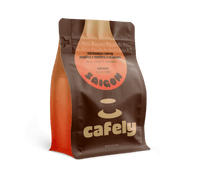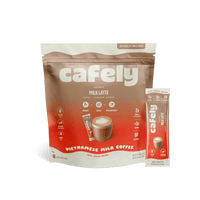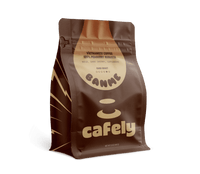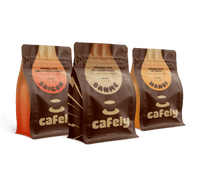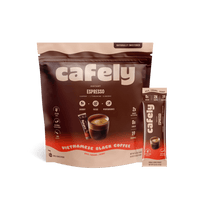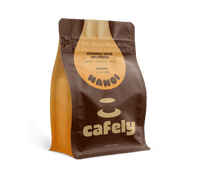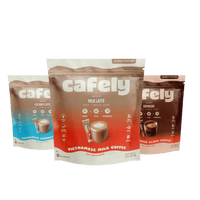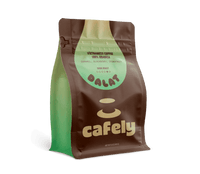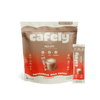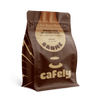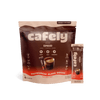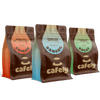So you’ve had a sip of Cuban coffee and feel like you can run a marathon. It’s not your imagination. That tiny cup packs a punch stronger than your average brew.
In this article, we explore why Cuban coffee is so strong, the caffeine levels in different types of Cuban coffee, and how to make a cafecito.
What Is Cuban Coffee?
If you enjoy a cup of espresso coffee, you'll love Cuban coffee. It's traditionally made with a moka pot and served in small cups, but several cafes in and outside of Cuba use modern espresso machines.
The “Cuban coffee” isn't technically one brew. There are four types, each made with strong, concentrated coffee that represents the country’s coffee culture — the cafecito coffee, colada, cortadito coffee, and café con leche.
However, they all have two things in common — espuma (a sweet sugar foam) and their high caffeine content.
How Much Caffeine is in Cuban Coffee?
The caffeine content in Cuban coffee varies depending on the serving size and format — cafecito, colada, cortadito, and café con leche. However, the average brew contains between 50 and 80 mg of caffeine per serving.
This is roughly the same as a shot of espresso, a cup of arabica drip coffee, or a regular iced coffee. However, Cuban coffee is typically enjoyed in smaller servings — less than two ounces (60 mL).
Different Types of Cuban Coffee & Their Caffeine Levels
Here are the four types of Cuban coffee, what makes each one unique, and how much caffeine they have:
1. Cafecito

The cafecito contains between 40 and 70 mg of caffeine.
This coffee is dubbed “the Cuban espresso.” It consists of a shot of black moka pot coffee topped with a sweet, thick espuma. The cafecito is served in demitasse cups or small heat-proof glass mugs. Each serving has a volume of 1 to 2 oz (30 to 60 mL).
2. Colada

The colada is a larger version of the cafecito. It’s usually split into six thimble-sized styrofoam cups called tacitas. A whole colada contains 250 to 350 mg of caffeine, and each tacita contains 30 to 50 mg of caffeine.
The colada is made to be shared among a group of friends and family. It's a common social ritual that's regularly enjoyed during a work break or weekend get-together.
A whole colada contains around 6 oz (180 mL) of moka pot coffee, and each tacita has a capacity of around just under 1 oz (22 to 30 mL). The drink is topped with an espuma, which is spooned into each cup just before serving.
3. Cortadito

The cortadito contains 40 to 80 mg of caffeine.
This Cuban coffee is also made with a moka pot and is essentially a cafecito served with steamed milk at a 1:1 ratio. The sweet espuma and creamy milk balance the strong coffee. This brew has a volume of around 4 oz (120 mL) and is traditionally an after-dinner treat.
4. Café Con Leche

The café con leche contains 40 to 75 mg of caffeine per serving.
This brew is often dubbed “the Cuban latte.” It consists of a cafecito and steamed milk at a 1:2 ratio. A serving is around 6 oz (180 mL). However, the milk and coffee are typically served in separate cups. This allows the drinker to combine the two according to their taste.
As a breakfast drink, the café con leche is usually paired with a slice of bread and butter.
What Makes Cuban Coffee so Strong?
Several factors contribute to the strength of Cuban coffee, including the beans used, the brewing method, and how it's served.
Here are the reasons Cuban coffee has such an intense flavor and high caffeine content:
1. The Coffee Blend Used
Cuban coffee is made with an intense, dark roast blend of both arabica and robusta. The arabica provides sweet, smooth, delicate flavors, and the robusta produces dark, bold, bitter notes and a strong caffeine hit.
The robusta beans in the Cuban coffee blend are what give this brew its strength. They have around twice the amount of caffeine as arabica coffee beans.
2. The Brewing Method
Cuban coffee is traditionally made with a moka pot — a stovetop brewer that works by forcing hot, pressurized water through finely ground coffee. This extraction method results in a strong, concentrated brew with low volume.
You can also make the drink with an espresso machine. This produces a strong, concentrated shot in a similar way.
3. The Serving Size
Cuban coffee is usually served in small cups. The cafecito and colada are poured black in cups of no more than one or two ounces (30 to 60 mL). Even the milk-based Cuban coffees — the cortadito and café con leche — are no more than six ounces (180 mL).
This small serving size means the coffee has a high caffeine concentration. Although an espresso shot diluted with milk or water is just as strong as a Cuban coffee, the latter contains more caffeine per milliliter. This gives the brew an intense, strong flavor and an instant energy boost.
How to Make a Strong Cuban Coffee (Cafecito)
Making a strong cup of Cuban coffee isn’t a difficult process. However, it’s a bit of an art form and requires a few more steps than brewing a simple espresso shot.
Here’s everything you need to make a strong cafecito (the Cuban espresso):
What You’ll Need
- High-Quality Coffee — Opt for a high-quality, whole-bean arabica and robusta blend such as Saigon OG.
- Water — Use fresh, filtered water when brewing your coffee.
- Sugar — You’ll need around one teaspoon of refined white sugar per serving to make the espuma.
- Moka Pot — Traditional Cuban coffee is made with a moka pot, but you can also use an espresso machine.
- Demitasse Cup — The cafecito is served in small demitasse cups. If you don’t have one, use your smallest coffee cup.
- Small Bowl — You’ll need a small bowl to mix the coffee and sugar to make the espuma.
- Teaspoon — A teaspoon is needed for measuring the sugar and collecting the coffee. Most Cubans also use a small spoon to whip the espuma.
- Fine Whisk (Optional) — If you don’t have the technique of making espuma with a teaspoon, use a fine whisk.
Brew Guide: Cafecito
- Measure & Grind the Coffee — Grind your coffee to a fine consistency similar to powdered sugar. You'll need enough to fill the filter basket of your moka pot.
- Prepare the Moka Pot — Fill the filter basket of your moka pot with ground coffee. Fill the bottom chamber with fresh, filtered water. Assemble the moka pot and place it on your stove.
- Start Brewing — Turn your stove to medium and wait for the pot to begin gurgling. This indicates that the pot has started brewing.
- Prepare the Sugar — Add one to two teaspoons of sugar in a small mixing bowl.
- Make the Espuma — As the first few drops of coffee come through the spout in your moka pot, gently open the lid and scoop a teaspoon of the brew into the mixing bowl with a spoon. Whip the coffee and sugar together with a spoon, fine whisk, or milk frother until a sticky, dense foam forms.
- Assemble the Cafecito — Once your moka pot finishes brewing, remove it from the heat and pour the shot into a small cup. Gently spoon the espuma onto the surface of the brew. Serve and enjoy while hot.
FAQs: Why is Cuban Coffee So Strong?
Do you want to learn more about Cuban coffee and other strong brews? Read through the answers to the frequently asked questions below for more information.
1. What Is Cuban Coffee?
Cuban coffee is essentially espresso coffee that's sweetened. It's typically made using a robusta and arabica blend in a moka pot — a small stovetop brewer that creates espresso-like coffee.
Although there are a few types of Cuban coffees, the main defining feature is “espuma” — a sweet, sticky foam on top of the brew that's made by whipping coffee and sugar.
2. How Much Caffeine Is in a Cafecito?
The average cafecito contains around 80 mg of caffeine per cup. However, the caffeine level can vary dramatically depending on the blend used and how it's made — espresso or moka pot.
3. What’s the Foam on Top of Cuban Coffee?
The foam on top of Cuban coffee is called “espuma.” It's a sweet, rich, dense foam created by whipping the first drops of coffee from the moka pot with white sugar. The mixture is whipped until it forms into a sticky foam. This foam is added to cafecito, colada, cortadito, and café con leche coffees — it's what makes Cuban coffee so unique.
4. Is Espresso Stronger Than Cuban Coffee?
Most Cuban coffees are stronger than espresso. A single shot of espresso contains around 60 to 80 mg of caffeine, whereas a similar-sized Cuban coffee contains 60 to 150 mg. This is largely due to the robusta and arabica blend used.
5. What is a Moka Pot?
A moka pot is a small stovetop brewer that creates strong, concentrated coffee. It works by forcing hot, pressurized water up through finely ground coffee. The moka pot is typically used to make espresso-like shots and Cuban coffee.
6. Can You Make Cuban Coffee With an Espresso Machine?
Yes. Although the moka pot is the traditional way to make Cuban coffee, several Cuban cafes and restaurants use espresso machines. The espuma is still made from the first few drops of coffee, and the bold flavors of espresso are almost identical to those created by the moka pot.
7. What’s the Strongest Type of Coffee Bean?
The strongest type of coffee bean is robusta, from the Coffea robusta species. This bean is around twice as strong as arabica, producing around 1.83 mg of caffeine per gram.
8. What’s the Best Coffee for Making Cuban Coffee?
The best coffee for making Cuban coffee should be high-quality whole-bean coffee that’s recently roasted. The beans should be ground fresh just before brewing for the most flavorful cup. Blends of both robusta and arabica are traditionally used — this is what gives Cuban coffee its balanced, dark, rich flavors and strong caffeine hit.
9. What Are the Main Ingredients in Cuban Coffee?
Most Cuban coffees consist of water, sugar, and coffee. However, some brews, such as the cortadito and café con leche, also contain steamed or frothed milk.
10. Is a Cortado the Same as a Cortadito?
The cortado and cortadito are both similar. The cortado is a Spanish creation that was introduced to Cuba during the late 19th century. The Cubans put their own touch on the cortadito by adding “espuma” — a sweet foam made by whipping coffee and sugar, while the cortado doesn't contain espuma.
